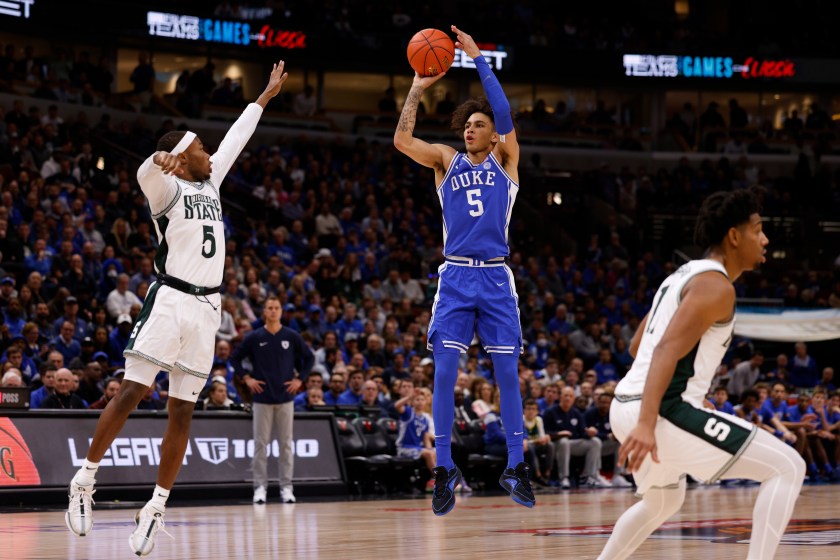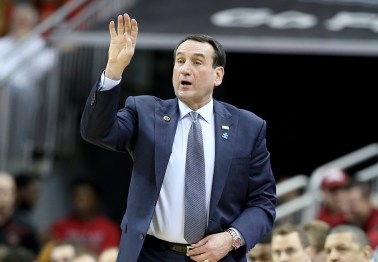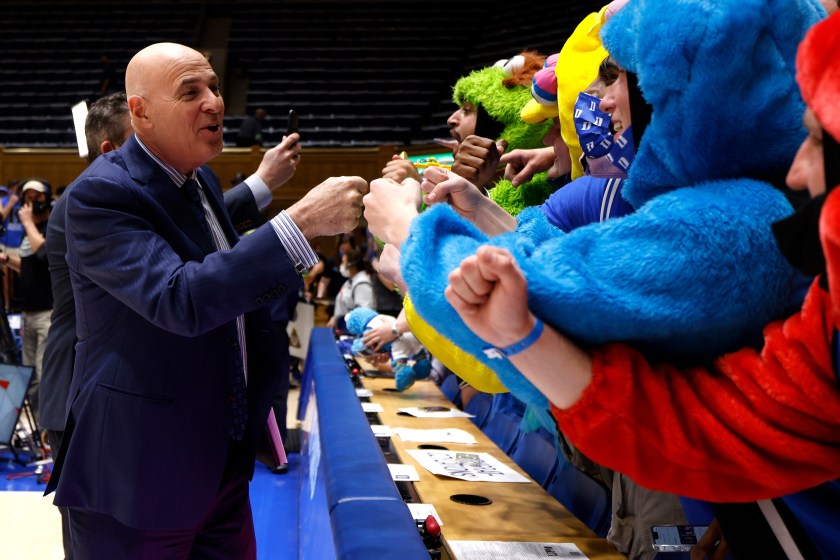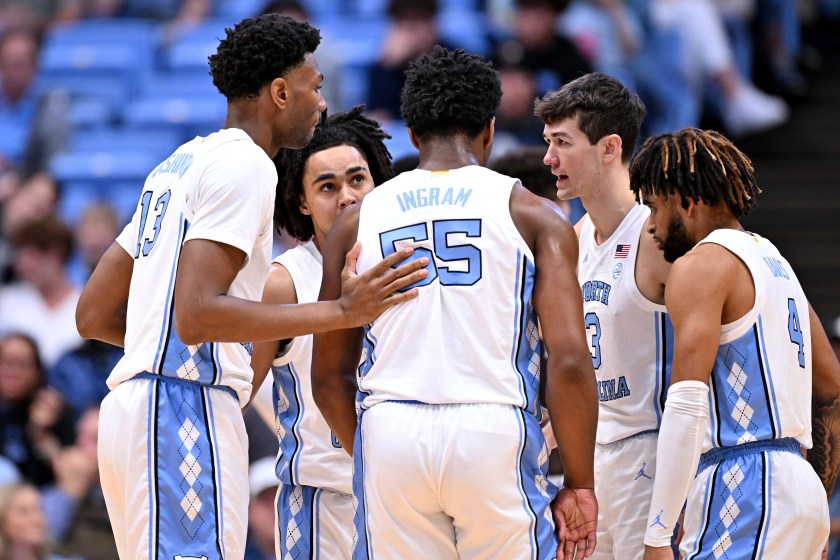Looking to steal the signs from Clemson's basketball team? You don't need to have assistants buy tickets to their games or wear disguises.
Usually, all you need to do is look over toward the bench. Tigers assistant coach Dick Bender writes the offensive set he wants the Tigers to run on a whiteboard and holds it up for all to see.
He's not alone. Plenty of coaches in college basketball use whiteboards to make sure their players know what to run, even in a noisy road arena. The ones who don't write down their plays don't use much more subtlety.
As Duke and Arizona played a tight game between top 12 teams — in an arena where the noise level of the crowd reached 117 decibels — the game was tied midway through the first half.
Point guard Tyrese Proctor brought the call upcourt and looked over at his coach on the sideline. Jon Scheyer gave him an emphatic thumbs-down gesture and shouted the word, "Down."
As Proctor crossed halfcourt with the ball, he held his free arm out straight and turned his own hand into a thumbs-down gesture.
It wasn't an opinion on the state of the offense so far. Thumbs-down is a set Duke has run for years, dating back to coach Mike Krzyzewski's heyday in Durham. Jahlil Okafor got open for dunks on thumbs-down in 2015. The Plumlees got open shots from thumbs-down five years before that.
It basically involves a the point guard taking the ball to a spot on the wing, well beyond the 3-point line, and keeping his dribble alive while a forward sets a down screen — hence the "down" in the name. Depending on how the defense reacts, it can result in a curl for an open shot or a flare for a 3-point attempt or an isolation for a big man.
Arizona immediately reacted, positioning defenders around the spot on the floor where the screen would be set by Mark Mitchell, allowing them to switch without losing track of either man. They knew what "thumbs-down" was and, clearly, they knew Duke was about to run it.
Ironically, while that game was going on, the college football world was waiting for Michigan's team plane to land in State College, to get a reaction on head coach Jim Harbaugh being suspended by the Big Ten over the school's intricate scheme to steal opponents' signs. The assistant reported to be responsible for the thefts had already resigned earlier in the month.
The scheme needed to be complex, because college football teams go to great lengths to conceal their signs, using multiple decoy signal callers standing side by side, weird logos and icons on play cards, resembling some type of modern hieroglyphics and, on occasion, large opaque screens held on either side of the signal callers, so signs can't be read from the press box.
Bill Belichick also ran afoul of the NFL for going to great lengths to steal signs. And in MLB, the Houston Astros are still booed over their scheme to steal signs, a scandal that inspired baseball to implement a high-tech communications system between pitcher and catcher to avoid any future incidents.
And yet, in college basketball, teams make seemingly no effort to conceal what their plans are. According to NBA lore, one of the myriad ways Michael Jordan would talk trash was to tell a confused rookie what play his team wanted to run and where the youngster was supposed to go on the floor.
So, why don't coaches try to get an advantage — however slight — by concealing signs in college basketball?
Basketball is Much Different Than Other Sports
One reason is the nature of the game. Basketball is considered more of a free-flowing game where the players are in charge. Much more is left up to on-court decisions than is the case in football or baseball.
"Our game is more spontaneous, read-and-react," said Seth Greenberg, former Virginia Tech head coach and now a TV analyst. "If I know that guy's throwing a fastball, then when it leaves his hand, it's going to be a fastball. This is a little bit different."
When Duke goes to "thumbs-down" or Clemson runs "Spoelstra," it's just a starting point — where the players should go on the floor and what they should do as the play starts. From there, there is a seemingly endless set of if-then branches coming out of what the defense does.
"Here's the difference," Greenberg said. "You can be running horns (an offensive set with two high-post players that Duke also runs on occasion), but horns is run in relation to how it's defended. Our game is a read-and-react game. You can say horns, I can give you 15 different things you can do out of horns."
Greenberg then spoke at great length about hard hedge screens, flare screens, pistol action and shuffle cuts — all of which are possible outcomes in horns.
Of course, the same is true in football, where there is a play on paper, and then quarterback and receiver often have to improvise based on what the defense does. When announcers talk about a receiver "breaking off a route," that's what's going on.
Still Some Secrets
There are also many coaches who refuse to accept the premise that everything is known in college basketball.
"There absolutely are secrets," said James Johnson, a former North Carolina State assistant and former head coach who succeeded Greenberg at Virginia Tech. "Even the guys who hold up signs on whiteboards, there are times late in games when they'll turn them so our guys can't see what it says."
It's one of the reasons coaches save their timeouts for late in games.
"ATO (after time out) plays," Johnson said. "Teams have plays that they run after timeouts. That's something where we can't hear the call. They call it in the huddle. They go out. There's nothing audible. They just run the play. Sometimes you get caught off guard with a new set or something."
Coaches will generally let their players freelance more during the game, but, when it comes to key moments, they'll step in. That's when the cloaks and daggers come out of hiding.
"What you have to do as a coach is figure out what you're going to do to steal a basket," Greenberg said. "(Missed) free-throw plays. Coming out of timeouts. Are you going to change defenses one time when the other guy doesn't think you will? Because the games are closer. I did a study at Tech: If you can win special situations — under, side, out of timeout, first plays of half, free-throw situations — if you win those, you're going to win three or four more games a year."
Of course, despite the benefit of pulling out an occasional surprise, there's another key reason basketball coaches are hesitant to get too tricky when it comes to play-calling secrecy.
"Your guys need to know what they're supposed to be running," Greenberg said. "You get too cute, and you'll have somebody on your team running the wrong play."




